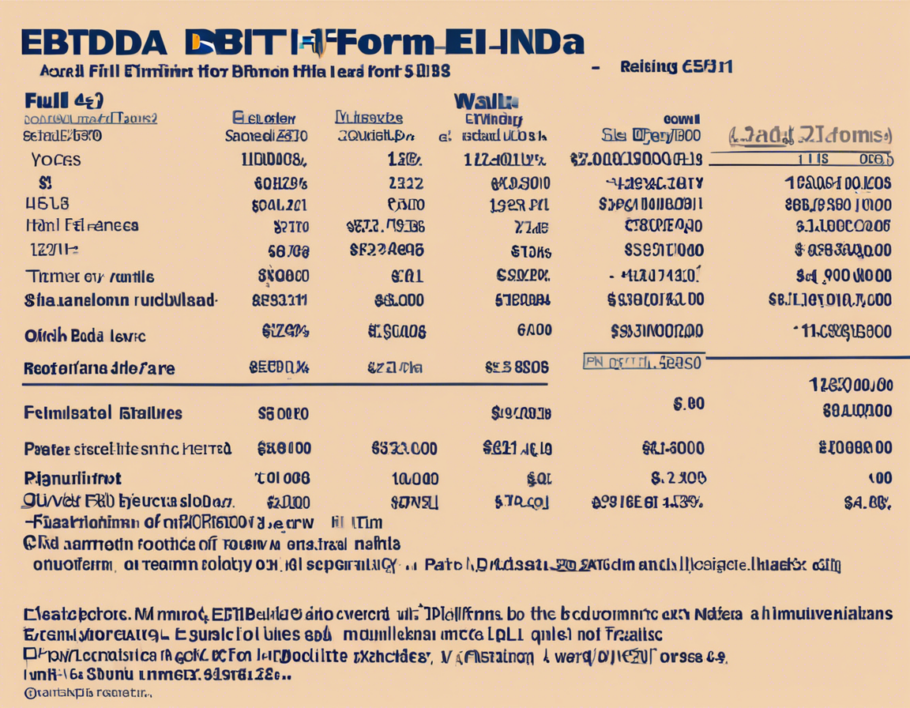EBITDA, or Earnings Before Interest, Taxes, Depreciation, and Amortization, is a financial metric often used by businesses to evaluate their performance. It provides a clearer picture of a company’s operational profitability by excluding various non-operating expenses. In this article, we will delve into what EBITDA is, how it is calculated, its significance, limitations, and why it is a valuable tool in financial analysis.
Understanding EBITDA:
What is EBITDA?
-
Earnings: This refers to the net income or profit generated by a company over a specific period.
-
Before: The term signifies that EBITDA is calculated before deducting interest, taxes, depreciation, and amortization expenses.
-
Interest: Refers to the interest expenses incurred by a company on its borrowings.
-
Taxes: Represents the taxes the company is obligated to pay on its earnings.
-
Depreciation and Amortization: These are non-cash expenses that reflect the decrease in value of tangible assets and the allocation of the cost of intangible assets over time, respectively.
Calculating EBITDA:
The formula to calculate EBITDA is:
EBITDA = Net Income + Interest + Taxes + Depreciation + Amortization
However, a more simplified version of calculating EBITDA is:
EBITDA = Operating Income + Depreciation + Amortization
Significance of EBITDA:
1. Operational Performance Evaluation:
EBITDA helps investors, analysts, and stakeholders assess a company’s core operational performance by eliminating the impact of non-operating factors like capital structure and accounting decisions.
2. Comparability:
As EBITDA removes varying financial structures and tax rates, it allows for easier comparisons between companies and industries.
3. Cash Flow Indicator:
While EBITDA is not a direct measure of cash flow, it can be a good proxy as it excludes non-cash expenses like depreciation and amortization.
Limitations of EBITDA:
1. Excludes Important Expenses:
Since EBITDA excludes crucial expenses like interest, taxes, and depreciation, it may present an overly optimistic view of a company’s financial health.
2. Ignores Capital Expenditure:
EBITDA does not account for the capital expenditures necessary to maintain or expand a company’s asset base.
3. Vulnerable to Manipulation:
As EBITDA is a non-GAAP metric, companies can manipulate it by making adjustments or excluding certain expenses to portray a more favorable financial position.
Why EBITDA is a Valuable Tool in Financial Analysis:
1. Performance Measurement:
By focusing on operational profitability, EBITDA provides a clear picture of how well a company’s core business is performing.
**2. Valuation:
EBITDA is commonly used in valuation metrics like Enterprise Value (EV)/EBITDA multiples in determining a company’s overall worth.
3. Strategic Decision Making:
Since EBITDA strips away non-operating factors, it helps in making strategic decisions regarding investments, mergers, acquisitions, and capital expenditures.
Frequently Asked Questions (FAQs):
1. Is a higher EBITDA always better?
Answer: While a higher EBITDA generally indicates better profitability, it is essential to look at the complete financial picture, including factors like debt levels and capital expenditures.
2. Can EBITDA be negative?
Answer: Yes, a negative EBITDA implies that a company’s operating expenses exceed its earnings. This could be a cause for concern, especially if it is a persistent trend.
3. How does EBITDA differ from net income?
Answer: Net income represents the company’s total earnings after deducting all expenses, including interest, taxes, depreciation, and amortization, whereas EBITDA excludes these factors to focus solely on operational profitability.
4. Is EBITDA the same as cash flow?
Answer: No, EBITDA is not equivalent to cash flow. Cash flow takes into account all cash inflows and outflows, including investments and financing activities, while EBITDA does not factor in such elements.
5. Can EBITDA be used for all types of businesses?
Answer: EBITDA is more commonly used for capital-intensive industries like manufacturing and telecom. For service-based businesses with fewer tangible assets, other metrics like EBIT (Earnings Before Interest and Taxes) may be more appropriate.
In conclusion, EBITDA serves as a valuable tool for investors, analysts, and companies to assess operational performance, make informed financial decisions, and facilitate comparisons within the industry. However, it is crucial to consider its limitations and use it in conjunction with other financial metrics for a comprehensive evaluation of a company’s financial health.

